
Apicomplexia)

The most characteristic features of
sporozoa are

1-unique appearance of most
protozoa makes it possible for
knowledge able person to identifiy
them to level of genus and spp. by
microscopic. alone.
2- motility is absent in most cell
except male gamete.
3-life cycle are cmplex ,with well
deve. A sexual and sexual stages

4-sporozoa produce special spore
like cells called sporozoite .
6-it is intracellular parasite with a
complex cycle alternating between
human and mosquitoes
7-have smiliar, independent
gametocyte the male are
microgametocyte and female
macrogametocyte

The female gametocyte produce a
single macrogamete ,and male
gametocyte produce multiple
gametes,
8- the oocyst in spp. Of isospora
and sarcocyst is produce 2 internal
sporocyst each with 4 sporozoites
,in cryptosporidium the sorocyst
stage is omitted

9- only 2 spp. Of coccidia are
known to undergo schizogony and
gametogony in man.

.
10-the cytoplasm and nuclei
divided like spores (sporogony)
inside the oocyst.
11- a thin walled oocyst may
rupture within the host and start
another auto-infections life cycle.

12-thick walled oocysts are stable
in the environment after passage
in the feces.

13- the troph. Undergo aform of a
sexual replication called
schizogony(multiple fission) to
produce merozoites withen a
membrane.

14-the merozoites differenciate
into macro. and microgametes and
following mating the life cycle is
repeated

Eimeria and Isospora
(coccidiosis)
Members of these two genera are
often referred to as the "coccidia."

The two genera contain a large
number of species
that infect a variety of animals
throughout the world.

The diseases caused by these
parasites are referred to
collectively as
coccidiosis, and they vary
tremendously in virulence.

Some species cause diseases that
result in mild symptoms that might
go unnoticed (i.e., mild diarrhea)
and eventually disappear,

while other species cause highly
virulent infections that are
rapidly fatal.

The life cycles of both genera are
similar. A host is infected when it
ingests oocysts that have been
passed in the feces of
another host.

The oocyst excysts in the host's
small intestine, and the sporozoites
contained within the oocyst are
liberated.

The sporozoites penetrate the cells
of the host's small intestine and
reproduce asexually. Each
generation of
asexual reproduction produces
multiple merozoites; the
merozoites are liberated from the
cell and infect new cells.

It is this stage of the infection that
can result in destruction of massive
numbers of cells in the host's small
intestine and,
ultimately, lead to the host's death.

Members of the genus
Cryptosporidium are parasites of
the intestinal tracts of fishes,
reptiles, birds, and mammals. It
seems that members of this genus
do not display a high degree of
host specificity, so the number of
species in this genus
remains a matter of some
discussion.

Some of the merozoites that enter
the host's cells transform into
gametocytes. The
gametocytes transform into
gametes, the gametes fuse, and
the resulting zygote begins to
develop into an oocyst.

The
developing oocyst escapes from
the host's cell, and it is passed in
the host's feces. Typically, when
the oocyst is passed in
the feces, it is not infective
because it does not contain
sporozoites; this is an unsporulated
oocyst.

After several days (or
weeks, depending on the species)
outside of the host's body, the
oocyst completes development
and sporozoites are found
within; this is a sporulated oocyst,
and it is infective to the next host
(view diagram of the life cycle).
Diagnosis

Diagnosis of the infection is based
on finding oocysts in the host's
feces. Differentiation of the two
genera and the species
within the genera is based on the
internal morphology of the oocyst.

Thus, while it is possible to identify
an unsporulated
oocyst as a coccidian oocyst, it is
virtually impossible to identify the
parasite that produced the oocyst
until the oocyst is
sporulated.

Asexual multiplication of the
parasite in the cells of the host's
small intestine is self limiting
(although in some species the
parasite actually kills the host
before asexual reproduction stops).

That is, after several generations of
asexual
multiplication, the parasite simply
stops dividing, the host stops
passing oocysts, and the host is
effectively cured of the
infection.
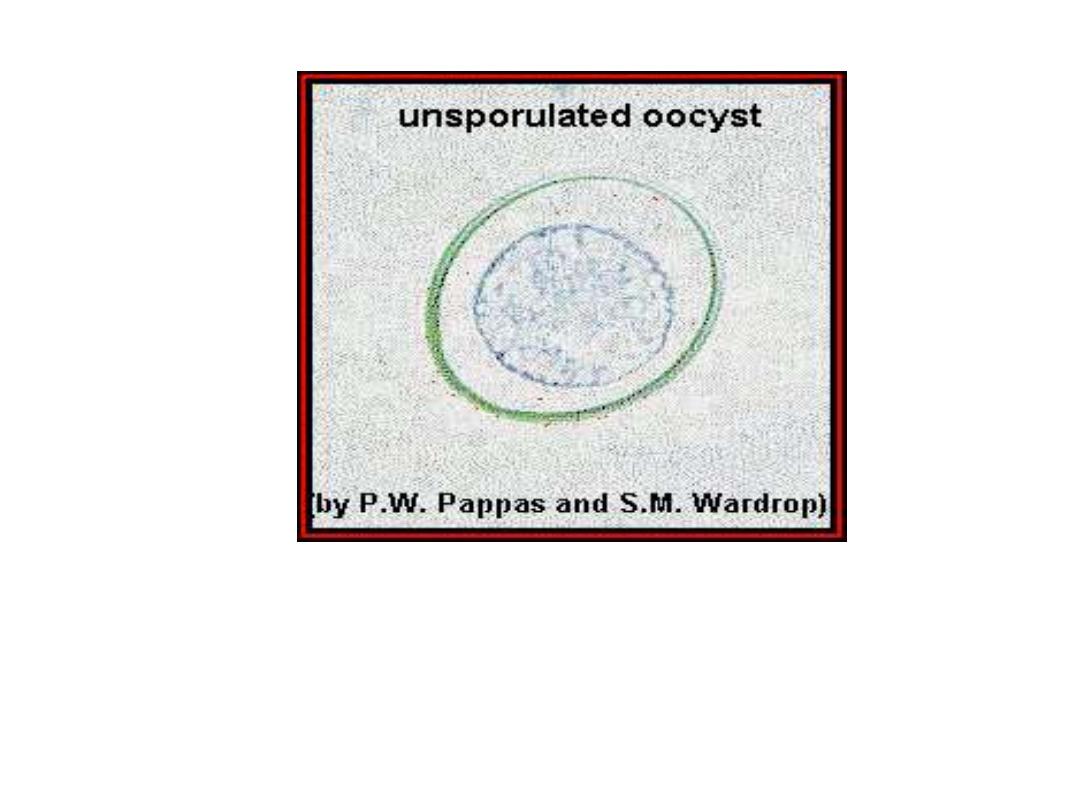
An unsporulated coccidian oocyst.
Such oocysts typically measure
between 35 and 50 μm

Another example of an
unsporulated oocyst
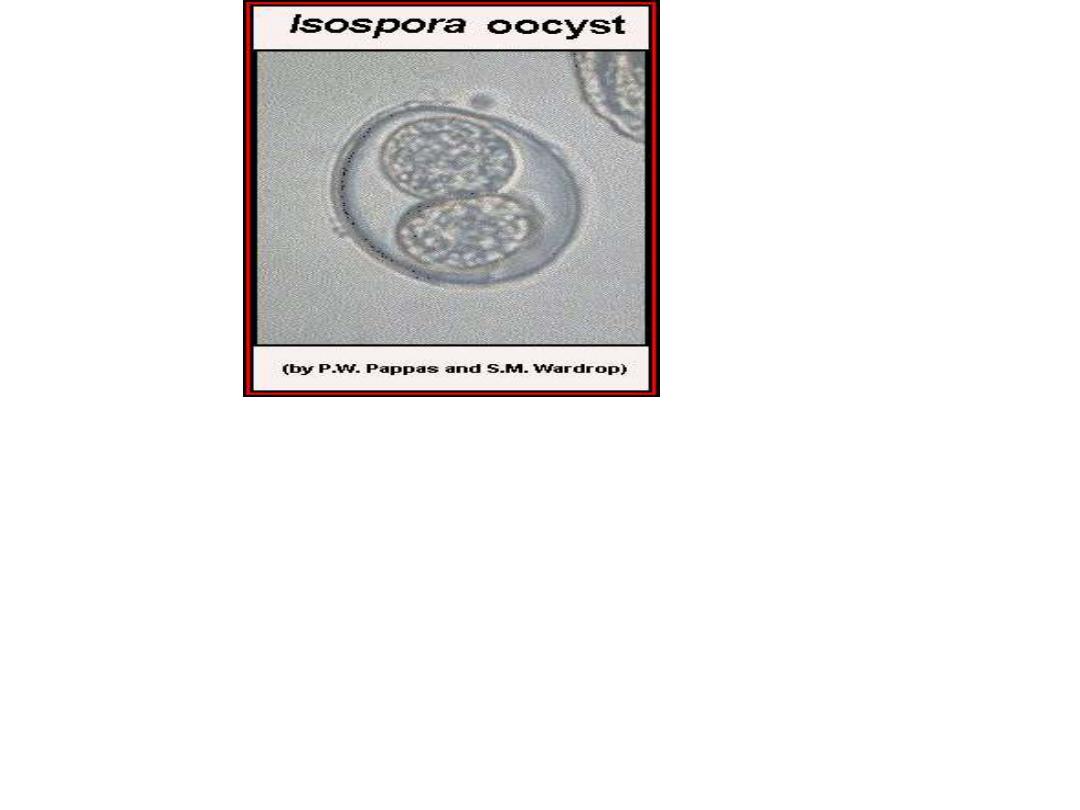
A sporulated coccidian oocyst. The
oocyst contains two sporocysts,
and this is typical of the genus
Isospora (and
Toxoplasma, although Toxoplasma
oocysts are much smaller).
Sporulated oocysts of the genus
Eimeria contain 4
sporocysts .
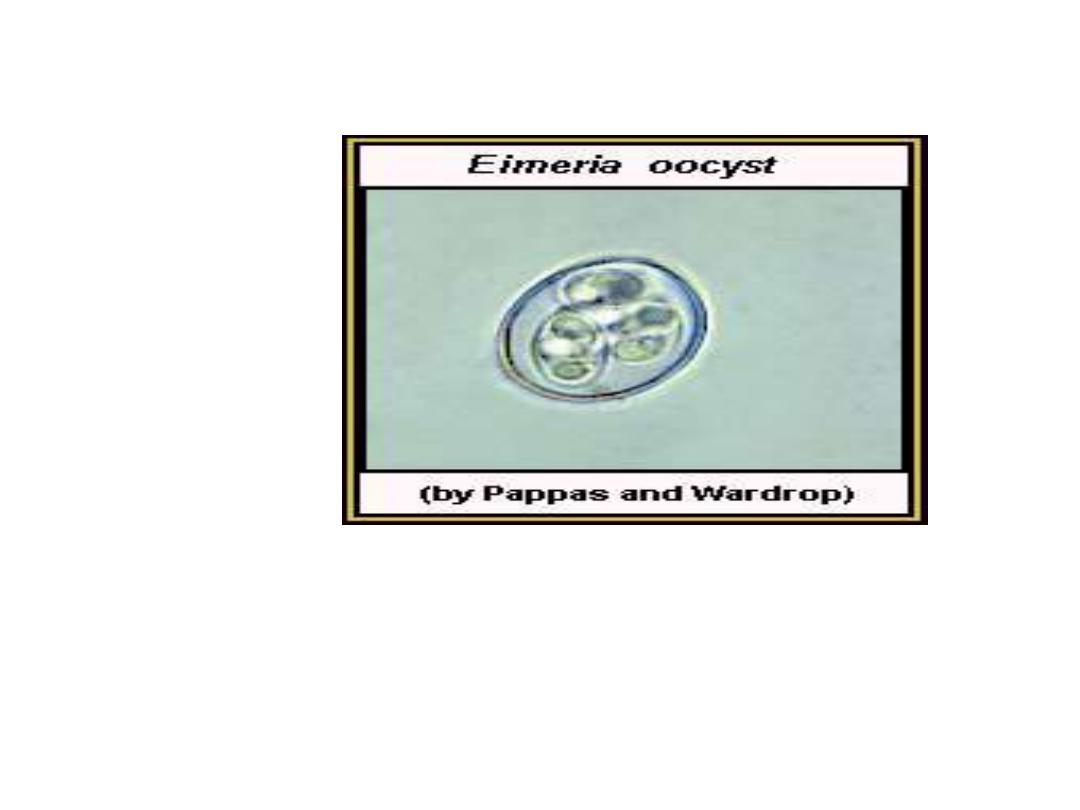
A sporulated oocyst of Eimeria sp.
This oocyst contains four
sporocysts (only three can be seen).
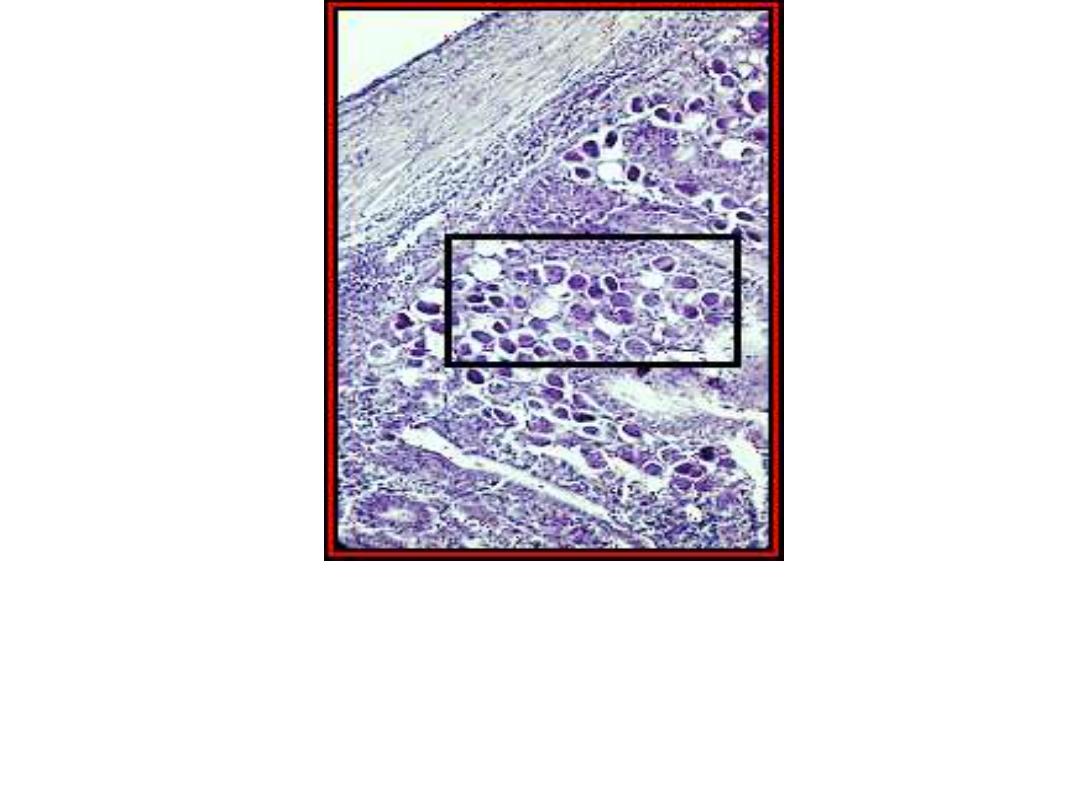
A histological section showing the
asexual reproductive stages of a
coccidian in the tissues of the host's
small intestine.
.
A

Note the many developing meronts
(=schizonts) (the large dark blue
structures enclosed within the
rectangle) in the
tissues. Each meront will produce
many merozoites

A histological section showing the
asexual reproductive stages of a
coccidian in the tissues of the
host's small intestine.
Note the many developing meronts
(=schizonts) (the large dark blue
structures enclosed within the
rectangle) in the
tissues. Each meront will produce
many merozoites.
A

Cryptosporidiosis
Cryptosporidium isolated from
humans is now referred to as C.
parvum.
Cryptosporidium infections have
been reported from a variety of
wild and domesticated animals,. CC

and in the last six or
seven years literally hundreds of
human infections have been
reported, including epidemics in
several major urban areas in
the United States

Cryptosporidiosis is now recognized
as an important opportunisitic
infection, especially in
immunocompromised hosts.

Cryptosporidium is a small
parasite, measuring about 3-5 μm.
It lives on (or just under) the
surface of the cells lining the
small intestine, reproduces
asexually, and oocysts are passed
in the feces

Transmission of
the infection occurs via the
oocysts. Many human infections
have been traced to the
contamination of drinking water
with
oocysts from agricultural "run-off"
(i.e., drainage from pastures), so it
is considered a zoonosis.

.
In most patients infected with
cryptosporidiosis the infection
causes a short term, mild diarrhea.
Since such symptoms are

associated with a number of
ailments, infected individuals may
not seek medical treatment, and
the infection may subside
on its own.


Thus, it is difficult to say how many
people are infected. On the other
hand, in persons with
compromised
immune systems, this parasite can
cause a pronounced, chronic
diarrhea

in severe cases the infected
individual may
produce up to 15 liters/day of
stools, and this may go on for
weeks or months.

Needless to say, such an infection,
if not
fatal unto itself, can exacerbate
other opportunitistic infections
common in immunocompromised
hosts.
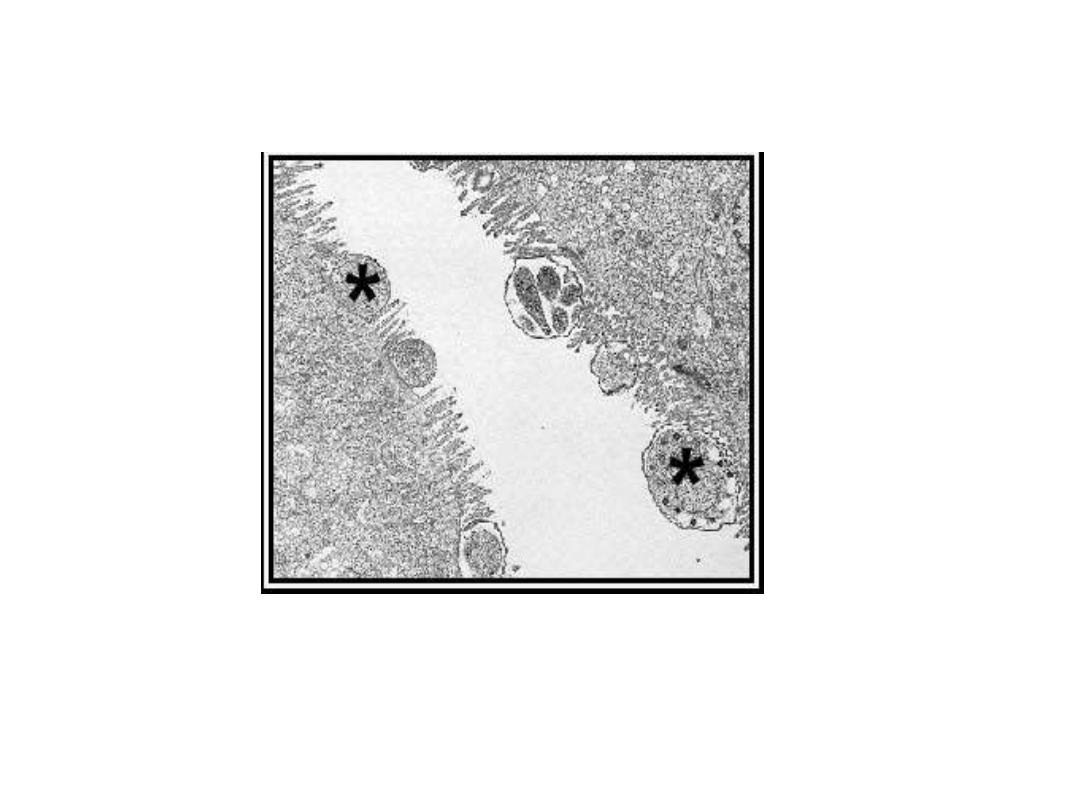

An electron micrograph showing
several stages of Cryptosporidium
(two are marked with asterisks) on
the intestinal
epithelium of a sheep. (From:
Gardiner et al., 1988, An Atlas of
Protozoan Parasites in Animal
Tissues, USDA
Agriculture Handbook No. 651.)
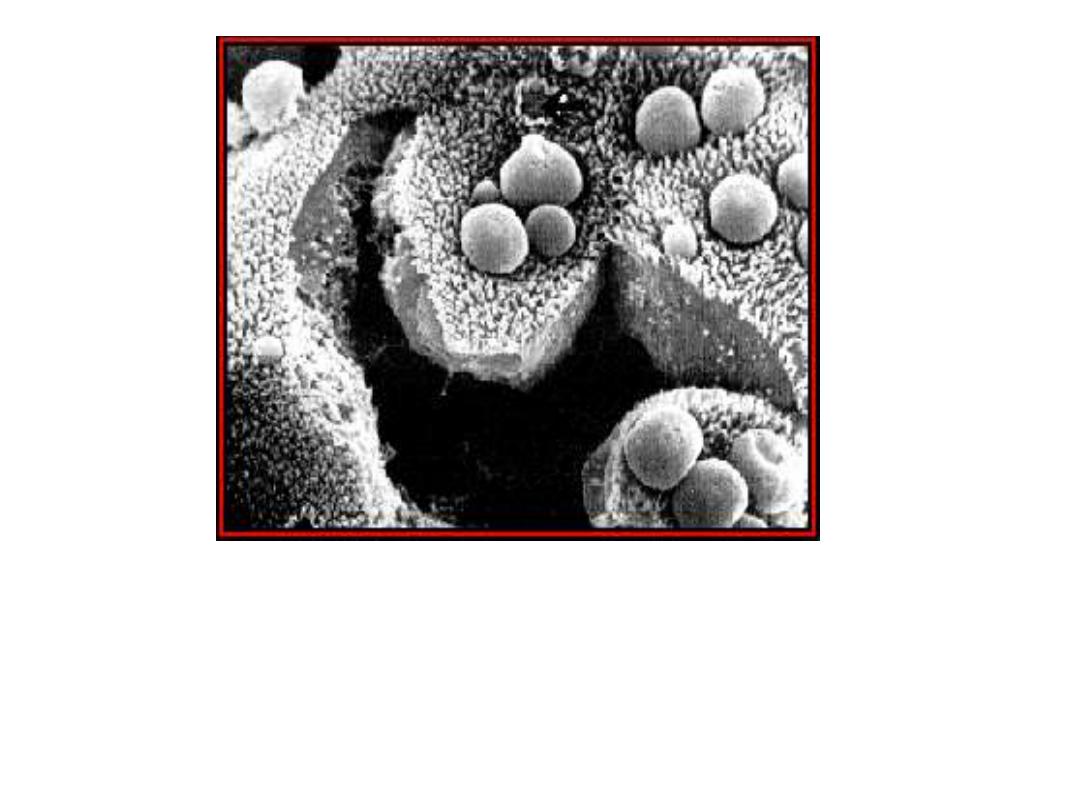
A scanning electron micrograph of
Cryptosporidium lining the
intestinal tract.
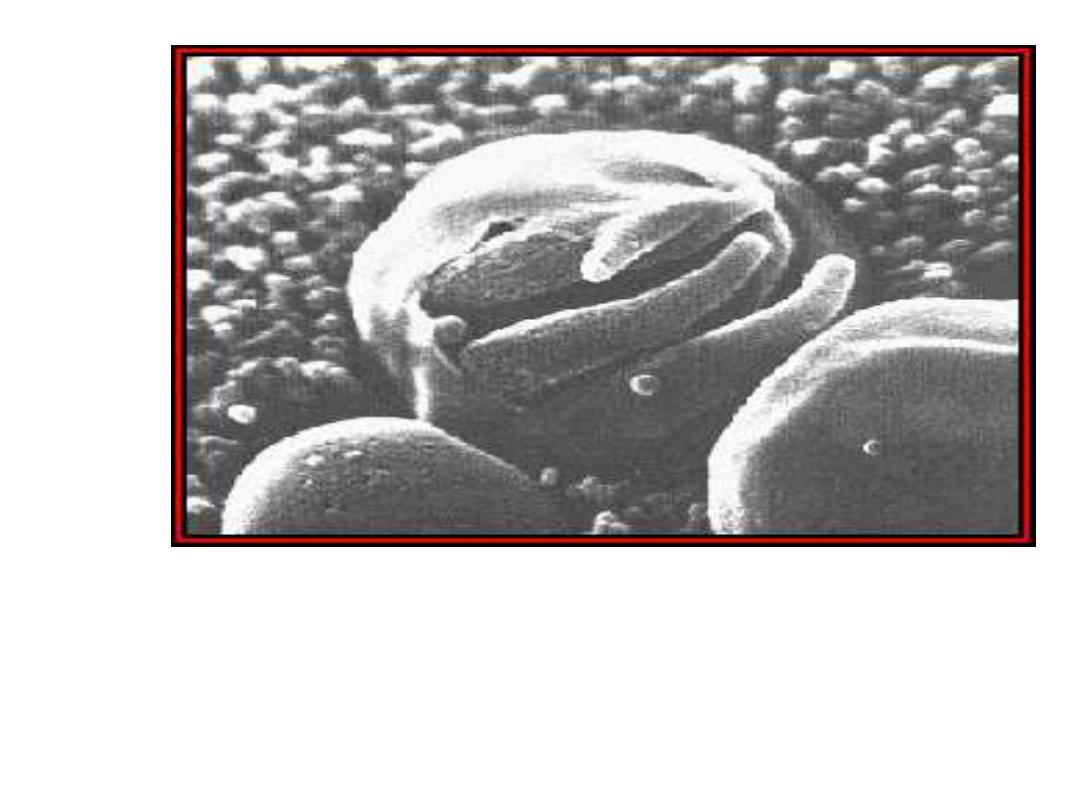
A scanning electron micrograph of
a broken meront of
Cryptosporidium showing the
merozoites within.
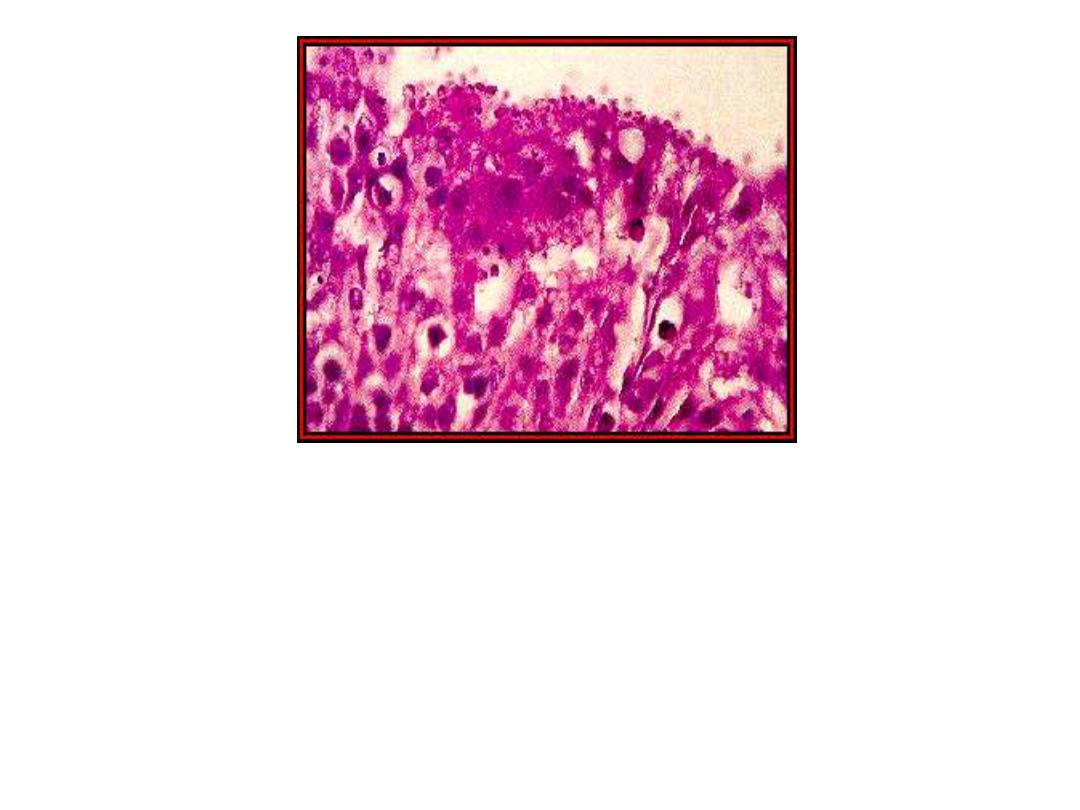
The trachea of a turkey "lined"
with numerous Cryptosporidium.
(From: Gardiner et al., 1988, An
Atlas of Protozoan
Parasites in Animal Tissues
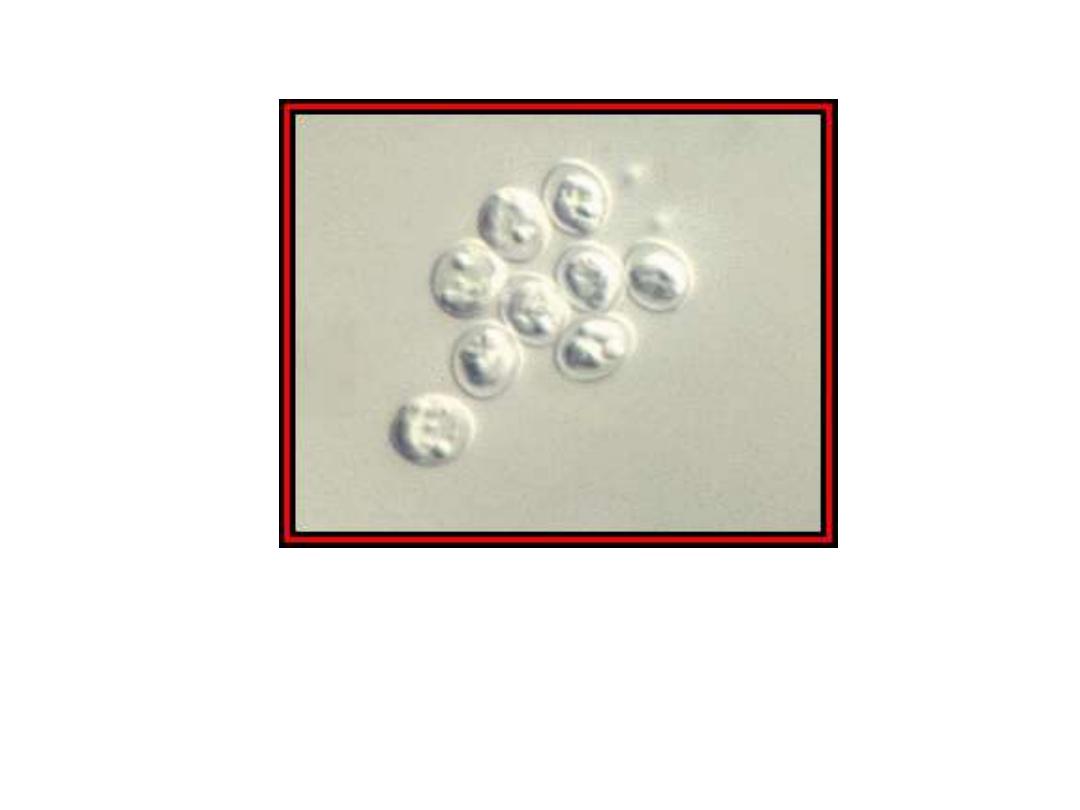
C
Cryptosporidium oocysts. (Original
image from a Japanese language
site tentatively titled Internet Atlas
of Human
Parasitology
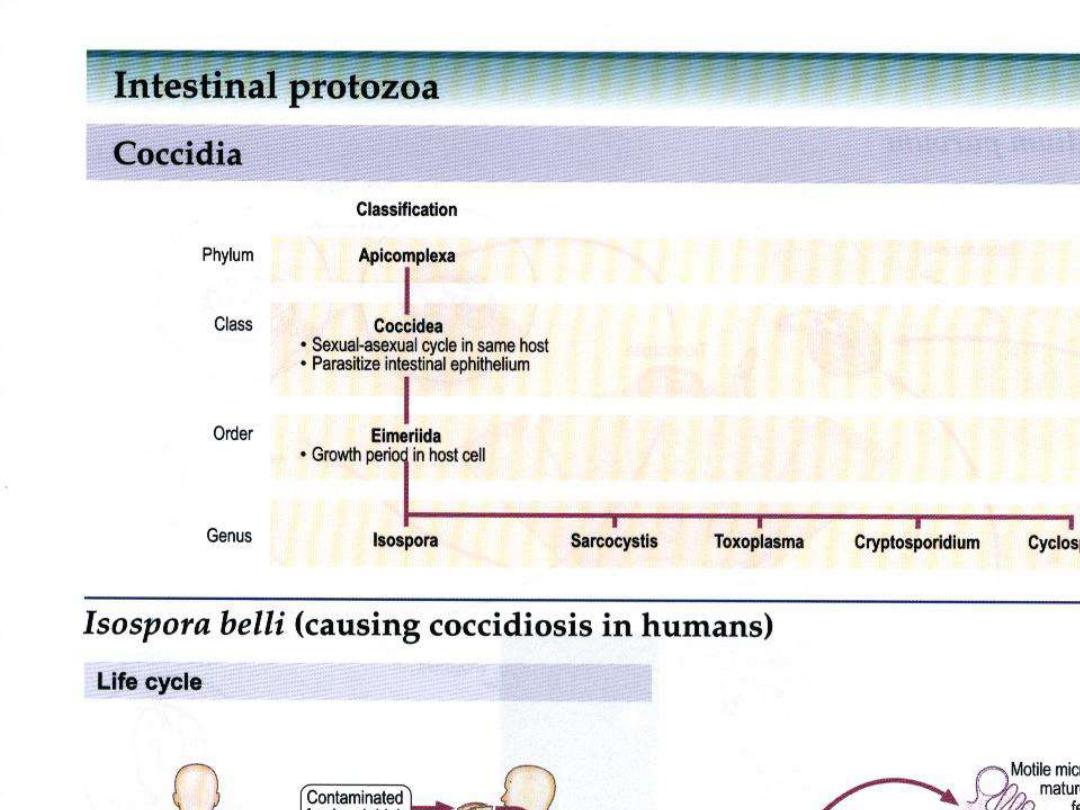
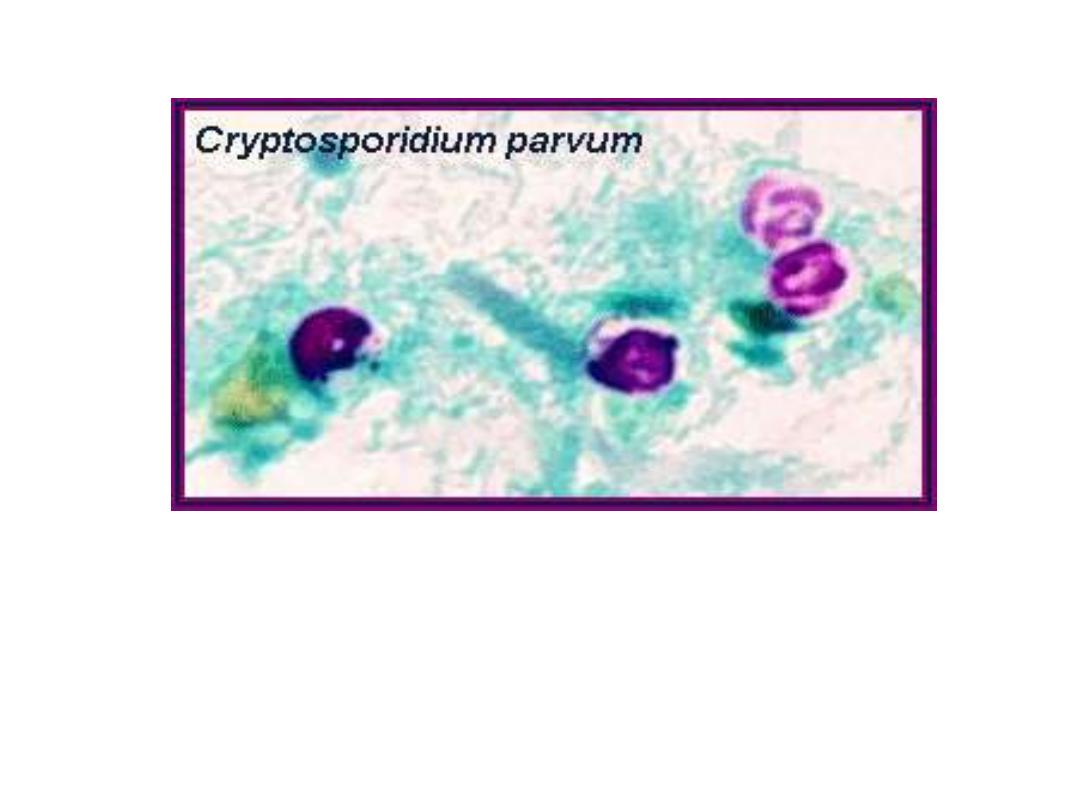
When stained using an
acidfastmethod, oocysts of
Cryptosporidium parvum stain bright
red or purple, as seen in this
preparation and used
with permission.)
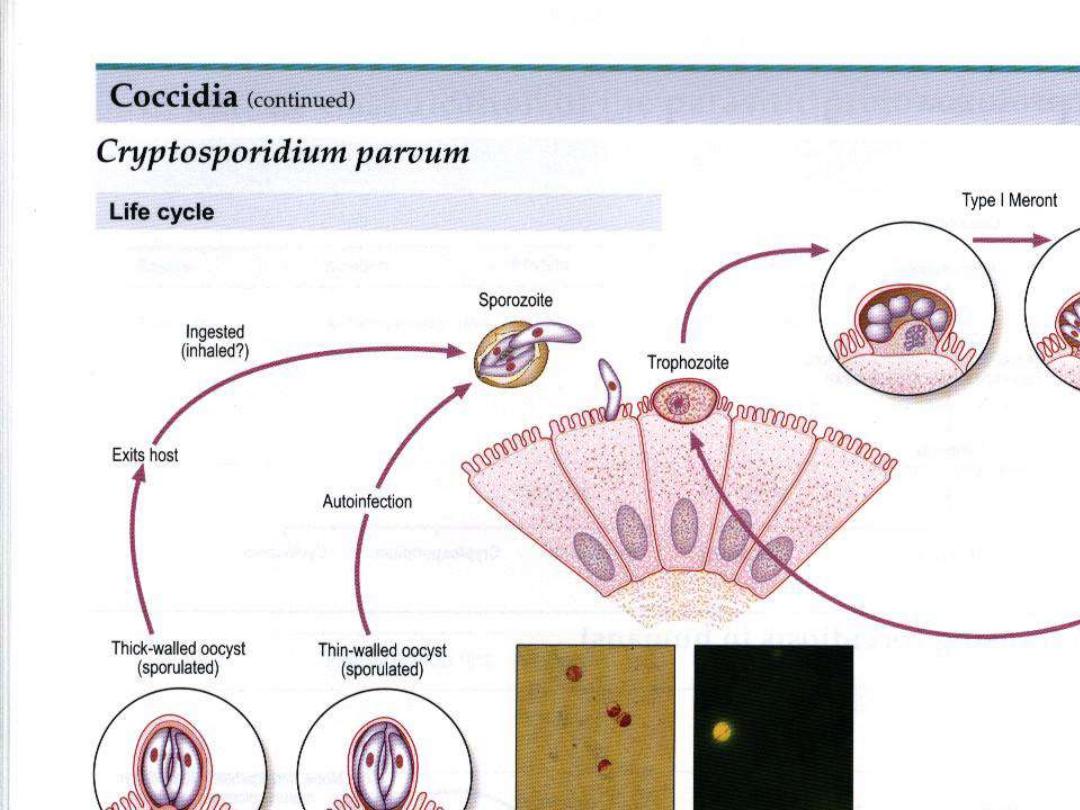
GIARDIASIS (lambliasis)
Etiology: Giardia lamblia
(flagellate)

Different between Isospora and
Eimeria sporulation.
